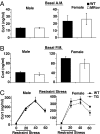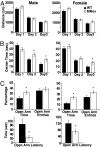Mineralocorticoid receptor overexpression in forebrain decreases anxiety-like behavior and alters the stress response in mice
- PMID: 17360585
- PMCID: PMC1838662
- DOI: 10.1073/pnas.0606067104
Mineralocorticoid receptor overexpression in forebrain decreases anxiety-like behavior and alters the stress response in mice
Abstract
Although numerous stress-related molecules have been implicated in vulnerability to psychiatric illness, especially major depression and anxiety disorders, the role of the brain mineralocorticoid receptor (MR) in stress, depression, and affective function is not well defined. MR is a steroid hormone receptor that detects circulating glucocorticoids with high affinity and has been primarily implicated in controlling their basal level and circadian rhythm. To specifically address the role of MR in hypothalamic-pituitary-adrenal axis activity and anxiety-related behaviors, we generated transgenic mice with increased levels of MR in the forebrain (MRov mice) by using the forebrain-specific calcium/calmodulin-dependent protein kinase II alpha promoter to direct expression of MR cDNA. A mild but chronic elevation in forebrain MR results in decreased anxiety-like behavior in both male and female transgenic mice. Female MRov mice also exhibit a moderate suppression of the corticosterone response to restraint stress. Increased forebrain MR expression alters the expression of two genes associated with stress and anxiety, leading to a decrease in the hippocampal glucocorticoid receptor (GR) and an increase in serotonin receptor 5HT-1a, consistent with the decreased anxiety phenotype. These data suggest that the functions of forebrain MR may overlap with GR in hypothalamic-pituitary-adrenal axis regulation, but they dissociate significantly from GR in the modulation of affective responses, with GR overexpression increasing anxiety-like behavior and MR overexpression dampening it. These findings point to the importance of the MR:GR ratio in the control of emotional reactivity.
Conflict of interest statement
The authors declare no conflict of interest.
Figures





References
-
- Chrousos GP, Gold PW. J Am Med Assoc. 1992;267:1244–1252. - PubMed
-
- De Kloet ER, Vreugdenhil E, Oitzl MS, Joels M. Endocr Rev. 1998;19:269–301. - PubMed
-
- Akil H. Nature Medicine. 2005;11:116–118. - PubMed
-
- Lopez JF, Chalmers DT, Little KY, Watson SJ. Biol Psychiatry. 1998;43:547–573. - PubMed
-
- Patel PD, Lopez JF, Lyons DM, Burke S, Wallace M, Schatzberg AF. J Psychiatr Res. 2000;34:383–392. - PubMed
Publication types
MeSH terms
Substances
Grants and funding
LinkOut - more resources
Full Text Sources
Other Literature Sources
Medical
Molecular Biology Databases

